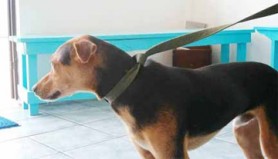Nosebleed
Pet Corner
There are some diseases of dogs and cats where one of the associate symptoms is a bleeding from the nostrils (epistaxis).
Nosebleeds develop when the blood vessels of the lining of the nostrils are ruptured. In addition to germs damaging the blood vessels in the nose, the rupture can be caused by vehement sneezing or by a grass seed (or some such foreign body) being stuck in the nostril.
On occasion, an ulcer could develop on the mucous membrane, or a bleeding tumour could result in the blood dripping (or even pouring) out of the nostrils. A hit on the nose bridge could also elicit a nosebleed.
It is quite a horrendous sight, especially when nothing can be done to stop the bleeding. People call in a panic and relate how the “entire” kennel or garage is covered with blood.
What’s worse is that no one wants to have such a bleeding dog sit in a car and mess up the upholstery. And if that is not bad enough, the situation can be further complicated (after the owner has persevered, albeit reluctantly, and brought the animal to the clinic) when the vet finds it difficult to quell the bleeding. More anguish ensues. This is truly one of those cases where the vet has first to pacify the owner before dealing with the patient.
Even while you are at home, may I suggest that you give the dog a sedative (a barbiturate, or a valium, or something similar). You might need to have one yourself, but I can’t really advise that (especially if you have to drive the animal to the clinic). You need all the faculties to be sharp when dealing with the pet’s nosebleeds.
Whether you have a sedative available or not, you must place an ice-pack on the nose bridge. If you do not have a commercial ice-pack at hand, you can make one by wrapping crushed ice in a light towel.
Keep the dog as quiet as possible. If the animal’s nose is still dripping blood, call your vet and alert him/her that you are on your way. Do not start poking around inside the nostril, or worse, trying to block up the nostril(s) with cotton wool. Messing around the inside of the nose will only provoke more sneezing, ergo more bleeding.
Please ascertain as accurately as possible how much blood the pet has actually lost. Your vet will need to know this, if the animal has to be placed under anaesthesia. In the case of tumours, X-rays might be useful.
If you have Vitamin K (tablets, drops, etc) available you may wish to contact your veterinarian and request the dosage rate. The vet will ask you many questions which you must answer truthfully.
A panicky answer does not help, especially if it is based on your thinking that you need to give the vet the answer you think he/she needs. Similarly, if you think that exaggerating the condition will make the vet more likely to respond with urgency, that is both unfair and not smart.

If the bleeding continues in spite of the ice packs and the Vitamin K, it is time to anaesthetize the animal and get into the nostril(s) (only the vet can do that). Sometimes the nasal cavity has to be cut open in an effort to find the ruptured blood vessel(s) or the tumour.
As an aside, allow me to mention that dogs do not ‘catch colds’ as humans do. So, if you see your dog with a runny nose, it might be an allergy or some form of nasal irritation (foreign body in the nostril) or even a tumour. If the runny nose with its clear liquid discharge gets worse and you see thick, sticky pus, especially if it is accompanied by a fever, one should think of canine distemper.
Next week we’ll deal with the issue of sneezing.
Please implement disease preventative measures (vaccinations, routine dewormings, monthly anti-heartworm medication, etc) and adopt-a-pet from the GSPCA’s Animal Clinic and Shelter at Robb Street and Orange Walk, if you have the wherewithal to care well for the animals. Do not stray your unwanted pets, take them to the GSPCA’s Clinic and Shelter instead. If you see anyone being cruel to an animal, or if you need any technical information, please get in touch with the Clinic and Shelter by calling 226-4237.




